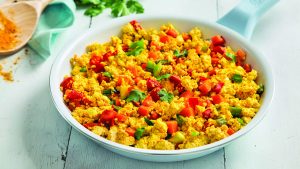‘The practice of fasting evolved as a means of self-understanding. For only by the act of volitional denial of a fundamental urge can its effects be clearly understood, and from this understanding one can then reprogram his behavior more in accord with his real needs. Accordingly, there are specific practices for fasting from food, sleep and sex – and a fourth practice for dealing with the uniquely human ego: speech fasting.’ — ‘Dhanwantari’ by Harish Johari
MUNG HUMUS
 For all types (Serves 2)
For all types (Serves 2)
Ingredients: Half cup split mung dhal; 1 cup boiling water; pinch of sea salt; half tsp fine black pepper; quarter cup minced onion; 2 tsp olive oil; 2tbs minced parsley; 1 tsp lemon juice; 1 tbs sunflower butter.
(Vata types use tahini instead of sunflower butter. Vata and Kapha types add 1 minced clove garlic; Pitta and Kapha types substitute chickpeas with mung; Kapha types use quarter tsp sunflower oil instead of the butter)
Method:
Wash mung dhal until water runs clear. Add to boiling water and cook over medium heat for 8 minutes. Remove mung from water when cooked but still firm. Using a potato masher, mash mung in a bowl and add salt and pepper.
Saute onion in olive oil for 3 minutes. Add minced parsley and sauté for an additional 3 minutes. Combine mung, onion, parsley mixture and lemon juice in a surbachi and grind to a fine paste. Add the sunflower butter and blend into the paste. For K and P types, serve on appropriate toast or crackers. For V types serve on moist, freshly baked bread.
(Courtesy Maya Tiwari’s `Ayurveda, A Life of Balance’)
TOFU SCRAMBLE
(This is a wonderful dish as the tofu absorbs all the flavours , so it’s very tasty. If possible, use frozen, leftover tofu as it easil crumbles. I like to serve this with a glass of almond milk for extra protein and natural oils. Makes 2-4 servings.)
crumbles. I like to serve this with a glass of almond milk for extra protein and natural oils. Makes 2-4 servings.)
Ingredients: 1 tsp ghee; 1 tbs onion, chopped (optional); 1 tbs coriander leaves, chopped (or parsley); quarter cup tomato, diced; quarter tsp green chili, minced; quarter tsp turmeric; salt to taste; 2 cups tofu, crumbled; 1 tsp water.
Method: In a medium frying pan on medium heat melt ghee. Add all the ingredients except tofu and water and sauté for two minutes. Add tofu and water and sauté for another 2-3 minutes. Until most liquid has been absorbed.
(Courtesy Amrita Sondhi’s `The Modern Ayurvedic Cookbook’)
BRAHMI TAMBULI
(Brahmi tambuli is an ideal dish for the summer. Avoid at night though or on cloudy days when there is a tendency to have  nasal, chest congestion, or the flu. Acceptable for all constitutions. Serves 2 to 3.)
nasal, chest congestion, or the flu. Acceptable for all constitutions. Serves 2 to 3.)
Ingredients: Half cup of brahmi leaves; quarter cup of coconut, grated; 2 cups of buttermilk; quarter tsp cumin seeds; 1 green chili; salt to taste. Seasoning: 1 tsp oil/ghee; quarter tsp mustard seeds; pinch of asafetida, 4 curry leaves.
Method: Grind together the brahmi leaves, grated coconut, cumin seeds, green chili, with a little buttermilk. Prepare a very smooth paste with this. Mix the remaining buttermilk with the ground mixture, add salt and mix well. Prepare the seasoning by heating oil, adding the mustard seeds, curry leaves, broken red chili and finally, hing. Pour this seasoning over the tambuli prepared. Serve at room temperature.
(Courtesy Reenita Malhotra Hora’s `The Ayurvedic Diet.’)
RIDGE GOURD SOUP
(Serves 3-4)
Ingredients: Two and half cups ridge gourd (turai), washed, cut into squares; 2 onions, chopped; 2 garlic cloves, chopped; 4  black peppercorns; salt to taste; 10 mint leaves, finely chopped, for garnishing; 1 onion, finely chopped.]
black peppercorns; salt to taste; 10 mint leaves, finely chopped, for garnishing; 1 onion, finely chopped.]
Method: Put ridge gourd into a pressure cooker along with two onions and garlic. Add the black peppercorns and cook with 2 cups water, till one whistle is released. Lower the flame and cook for 10 to 15 minutes. Remove from heat and allow to cool. Then put into blender and strain. You could add more water to get the consistency desired. Pour the stock onto a pan, add salt and bring to a boil. Serve hot garnished with mint and fine onion.
(Courtesy Gita Ramesh’s `The Ayurvedic Cookbook’)
MOAR KALI
 Ingredients: 1 cup rice flour; 3 cups buttermilk; half tsp turmeric powder; 4 tsp gingelly oil; 2 curd chilies (moar molagai); half tsp split black gram, skinless (dhuli urad dal); half tsp mustard seeds; 7-8 curry leaves. Salt to taste.
Ingredients: 1 cup rice flour; 3 cups buttermilk; half tsp turmeric powder; 4 tsp gingelly oil; 2 curd chilies (moar molagai); half tsp split black gram, skinless (dhuli urad dal); half tsp mustard seeds; 7-8 curry leaves. Salt to taste.
Method: Place the rice flour into a mixing bowl. Gradually whisk in the buttermilk so lumps are not formed. Continue stirring as you add the salt and turmeric powder. Set aside. Heat the gingelly oil in a thick-bottomed pan on low heat. Add the curd chilies and roast until they change color. Remove immediately and set aside. In the same oil, add the mustard seeds and allow them to splutter. Then add the split black gram. When it starts to change colour, add the curry leaves. Pour the rice flour and buttermilk mixture into the seasoning and stir vigorously, avoiding the formation of lumps. Cook on low heat.
Note: For a tangy twist to the dish, you can add a little tamarind water to the buttermilk. If desired, drizzle a little coconut oil on the kali before serving. While the kali is delicious by itself, it can also be had with your choice of sambar, pickle or chutney.
(Courtesy Isha Yoga Centre’s ‘A Taste of Well-Being’)
